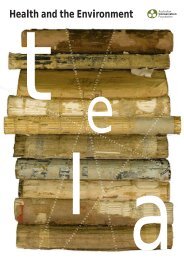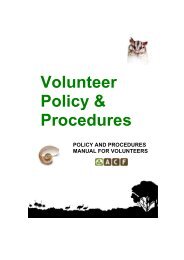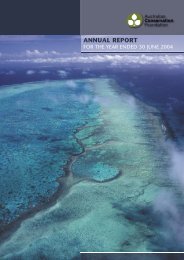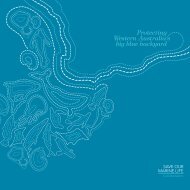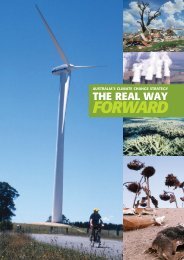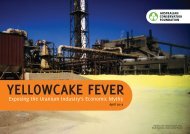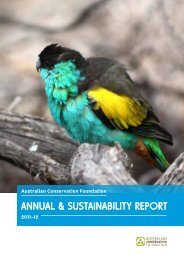Submission on Draft Water Sharing Plan for the Murrumbidgee River
Submission on Draft Water Sharing Plan for the Murrumbidgee River
Submission on Draft Water Sharing Plan for the Murrumbidgee River
You also want an ePaper? Increase the reach of your titles
YUMPU automatically turns print PDFs into web optimized ePapers that Google loves.
Inland <strong>River</strong>s Network and Nature C<strong>on</strong>servati<strong>on</strong> Council submissi<strong>on</strong>:<br />
<strong>Draft</strong> <strong>Water</strong> <strong>Sharing</strong> <strong>Plan</strong> <strong>for</strong> <strong>the</strong> <strong>Murrumbidgee</strong> Regulated <strong>River</strong> <strong>Water</strong> Source – 14 June 2002<br />
• Envir<strong>on</strong>mental water is c<strong>on</strong>tingent <strong>on</strong> irrigati<strong>on</strong> allocati<strong>on</strong> requirements and as such compromises <strong>the</strong><br />
protecti<strong>on</strong> and restorati<strong>on</strong> of <strong>the</strong> river’s ecological processes, its dependent ecosystems and native species.<br />
• Has no secure envir<strong>on</strong>mental water o<strong>the</strong>r than that <strong>for</strong> <strong>the</strong> maintenance of minimum flows.<br />
Envir<strong>on</strong>mental C<strong>on</strong>tingency/Health Allowance water is incorporated in <strong>the</strong> WSP as Class B<br />
Supplementary Envir<strong>on</strong>mental <strong>Water</strong>.<br />
• Has no methodology <strong>for</strong> managed envir<strong>on</strong>mental releases from stored water.<br />
• Stands in isolati<strong>on</strong> from <strong>the</strong> WSP’s of unregulated catchments, in particular Tarcutta Creek WSP, and<br />
identifies no envir<strong>on</strong>mental relati<strong>on</strong>ships.<br />
• Does not identify <strong>the</strong> ecological values that <strong>the</strong> <strong>Plan</strong> is to protect<br />
Minister’s Note: (Part B, p.11)<br />
IRN, NCC and ACF fully c<strong>on</strong>cur with <strong>the</strong> Minister’s Note <strong>on</strong> p.11 of Part B. The envir<strong>on</strong>mental flow rules,<br />
as <strong>the</strong>y stand in this <strong>Draft</strong> WSP, are extremely complex to <strong>the</strong> point that <strong>the</strong>y are virtually impossible to<br />
understand, review and identify <strong>the</strong>ir intended or likely outcomes. It would seem that <strong>the</strong> intent of this<br />
complexity is to reinstate <strong>the</strong> status quo and entrench <strong>the</strong> highly inappropriate irrigati<strong>on</strong> practices of <strong>the</strong> last<br />
30 years – which have led to this river being classified as ‘stressed’.<br />
The scientific evidence <strong>for</strong> this, as compiled in <strong>the</strong> report “The <strong>Murrumbidgee</strong>: assessing <strong>the</strong> ‘health’ of a<br />
working river”, jointly commissi<strong>on</strong>ed by <strong>the</strong> Agribusiness Task<strong>for</strong>ce, DLWC, <strong>the</strong> EPA and included several<br />
members of <strong>the</strong> irrigati<strong>on</strong> community, is unequivocal. It is <strong>the</strong>se practices that have led to <strong>the</strong> <strong>Murrumbidgee</strong><br />
<strong>River</strong> being brought to <strong>the</strong> brink of becoming an ecological basket case. The recent listing of <strong>the</strong> aquatic<br />
ecological community in <strong>the</strong> natural drainage system of <strong>the</strong> lower Murray <strong>River</strong> catchment as an endangered<br />
ecological community under <strong>the</strong> Fisheries Management Act 1994 is fur<strong>the</strong>r evidence of <strong>the</strong> desperate state of<br />
this river.<br />
Not <strong>on</strong>ly do <strong>the</strong> dissenting reports cast doubt about <strong>the</strong> ability of <strong>the</strong> proposed rules to maintain or improve<br />
<strong>the</strong> ecological health of <strong>the</strong> <strong>Murrumbidgee</strong> <strong>River</strong>, but <strong>the</strong> WSP also c<strong>on</strong>cedes as much. Table 1, Part A of<br />
<strong>the</strong> <strong>Plan</strong> indicates that <strong>the</strong> envir<strong>on</strong>mental provisi<strong>on</strong>s will <strong>on</strong>ly make a marginal improvement to flow<br />
c<strong>on</strong>diti<strong>on</strong>s compared to <strong>the</strong>1993/94 c<strong>on</strong>diti<strong>on</strong>s under <strong>the</strong> Murray-Darling Basin cap <strong>on</strong> water diversi<strong>on</strong>s.<br />
Minister’s Note: (Part B, p.9)<br />
The Minister’s Note <strong>on</strong> p.9 of Part B also correctly identifies, according to our envir<strong>on</strong>ment representatives,<br />
that <strong>the</strong> envir<strong>on</strong>mental water rules are overly focussed <strong>on</strong> providing flows to wetlands in <strong>the</strong> middle reaches<br />
of <strong>the</strong> <strong>Murrumbidgee</strong> <strong>River</strong>. There are significant wetlands <strong>on</strong> <strong>the</strong> lower floodplain of <strong>the</strong> river, notably <strong>the</strong><br />
Lowbidgee wetlands, which are not targeted and which presently receive a greatly reduced water supply.<br />
Changing <strong>Water</strong> Regimes and Wetland Habitat <strong>on</strong> <strong>the</strong> Lower <strong>Murrumbidgee</strong> Floodplain of <strong>the</strong><br />
<strong>Murrumbidgee</strong> <strong>River</strong> (Kings<strong>for</strong>d, R.T. and Thomas, R.F., 2001) documents how over 140 years of water<br />
resource development at a catchment and local scale has resulted in <strong>the</strong> disappearance or degradati<strong>on</strong> of at<br />
least 76% of <strong>the</strong> wetlands. In 1998/99 95% of diverted water reduced <strong>the</strong> amount of water reaching <strong>the</strong><br />
Lower <strong>Murrumbidgee</strong> floodplain by at least 60%. ‘Development’ of <strong>the</strong> water resource has not been evenly<br />
spread out over <strong>the</strong> 140 years. Kings<strong>for</strong>d and Thomas estimate that 26% of <strong>the</strong> floodplain was lost in <strong>the</strong><br />
period up to 1975. Over <strong>the</strong> next 23 years from 1975 to 1998 an additi<strong>on</strong>al 32% of <strong>the</strong> original wetland was<br />
lost. Of <strong>the</strong> remaining 42% of original wetland area in <strong>the</strong> Lower <strong>Murrumbidgee</strong> floodplain, 44% of <strong>the</strong><br />
perennial flood dependent vegetati<strong>on</strong> was in poor health or dead and defined as ‘degraded’.<br />
<strong>Water</strong> <strong>for</strong> o<strong>the</strong>r ecological requirements has also not been explicitly addressed by <strong>the</strong> plan. Fur<strong>the</strong>rmore, <strong>the</strong><br />
mimicking of natural flow variability below Burrinjuck Dam achieved by <strong>the</strong> 1998 rules is not fully<br />
maintained.<br />
Recommendati<strong>on</strong>s<br />
IRN, NCC and ACF are of <strong>the</strong> opini<strong>on</strong> that <strong>the</strong> envir<strong>on</strong>mental flow rules <strong>for</strong> <strong>the</strong> <strong>Murrumbidgee</strong><br />
Regulated <strong>River</strong> are totally inadequate and must be completely rewritten taking <strong>the</strong> following<br />
recommendati<strong>on</strong>s into account.<br />
- 5 -



